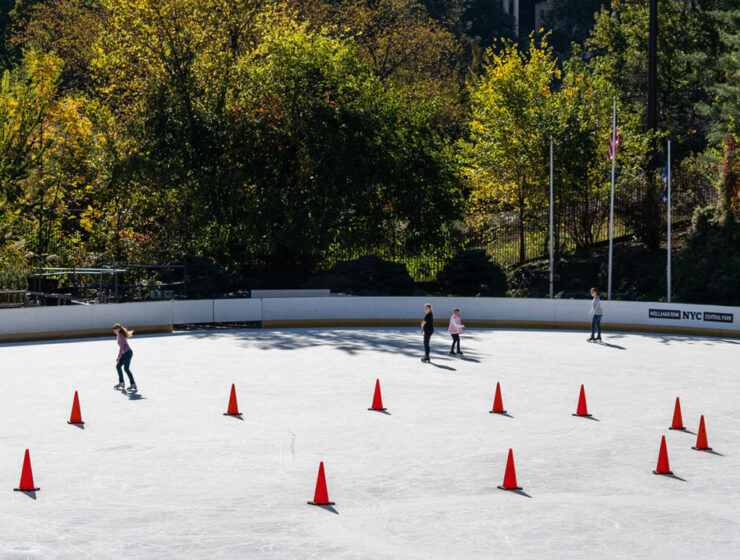Central Park is an oasis for urban-dwelling dog owners and their pets alike. There are 600,000 dogs (or a ratio of 6.8 dogs to every 100 humans) in NYC, and along with our 42 million human visitors, NYC Parks estimates a whopping 1.5 million canine visits to Central Park each year!
It may be tempting to think that you or your dog don’t have an influence over such a vast and bustling ecosystem. But imagine, for example, if each dog dug only one hole during their visit, had a single negative interaction, or if every owner neglected to pick up after their pets just once. The cumulative effect would be substantial, posing safety and public health risks. The Park’s vibrant environment—with its diverse communities of users and various species of birds, small mammals, and flora—suffers when its delicate balance is disrupted.
How can you keep your dog’s Park outings healthy and happy for your pet, your park, and the other animals that call these 843 acres home? We consulted the experts to bust some myths and share some tips to make your dog’s next visit harmonious for everyone involved.
Need a reminder of Central Park’s dog-related rules?
Our Dog Guide has got you covered with off-leash hours, dog-friendly locations in the Park, and spots where your pup isn’t allowed. While the Conservancy doesn’t enforce the rules, as stewards of the Park, we’re invested in working together with you to keep Central Park a safe space for all species.
Look for Compatible Play Styles
“One of the first things we learn as a dog trainer is that dogs have different play styles. It can be dependent on personality, breed, and other factors—and it also can be cultural or geographical. Rescues can bring dogs from around the globe and other parts of the country to NYC,” dog trainer Julie Wintrob explains. Julie is a trainer with the NYC-based organization Pawsome Pupstars and is Fear-Free Certified and a Certified Professional Dog Trainer-Knowledge Assessed (CPDT-KA®).
Especially in a place like Central Park—where millions of people come together with different dogs from various backgrounds—it’s understandable that dogs don’t always know how to communicate with each other effectively. Much like their human companions, they have unique preferences toward who they want to spend time with and how they enjoy spending time together. Whether you’re new to dog ownership or a longtime companion to canines, it’s essential to know your dog, their playstyle, and their limits before joining in on the fun
Follow local dog Moses on a tour through some of his favorite spots in Central Bark’s north end!
Learn to Speak Your Dog’s Language
Leashed or not, the best way to promote a positive experience for your dog and the Park community is to stay proactive, present, and mindful of your dog’s cues. Knowing your animal’s body language can take some time and attention, as cues can be tough to spot or unique to your pet and the situation. Think of it like learning another language. When your pet displays signs of stress or heightened arousal, it’s necessary to recognize that they may need help feeling safe or creating space from a stressor.
In such cases, Julie advises owners to briefly call their dog away to reduce their arousal levels. This step can prevent potential conflicts or misunderstandings with other dogs. While it doesn’t necessarily imply a dire situation, it’s an opportune moment to give your dog a well-deserved break.
Some dogs may benefit from remaining leashed all of the time. It’s essential to know your dog, understand the risks of off-leash time, and make the right decision for your dog’s health and safety.
Understand the Benefits of Leashed Outings
Not all dogs benefit from off-leash time—and that’s okay! In fact, off-leash outings may be detrimental for your dog in a number of cases. Dogs who become easily overwhelmed or have a history of negative experiences around other dogs might feel safer, more secure, and happier on a leash and at a distance.
“There’s a misconception that all dogs need a lot of physical exercise, or that [exercise] has to look a certain way. A related myth is that dogs should—or even need to—play with other dogs to be happy or healthy. These misunderstandings could cause pressure or shame for owners whose dogs aren’t able to partake harmoniously in these activities,” says Julie. “But some dogs are not actually getting the benefits of that off-leash time, because they’re stressed or anxious.”
No matter how well-behaved or adjusted your dog is—or how stellar their recall is—it’s important to remember that off-leash time always presents a degree of risk.
“Especially when it comes to an active public setting like Central Park—where you don’t have much control over the environment—it’s better to err on the side of caution, go slow, and decrease the risk of negative experiences,” Julie explains.






3 Comments
Id vim facilis ceteros percipit, altera phaedrum sea at, te alia novum praesent sit. Ne justo mazim delenit eam, pri ex brute interpretaris, invenire.
Praesent finibus congue euismod. Nullam scelerisque massa vel augue placerat, a tempor sem egestas. Curabitur placerat finibus lacus.
Ut enim ad minim veniam, quis nostrud exercitation ullamco laboris nisi ut aliquip ex ea commodo consequat. Duis aute irure dolor in reprehenderit.